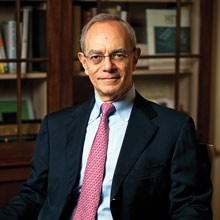MIT in the World
Embracing our global future.
November 8, 2014, marks a milestone for MIT: the first time that the members of the Executive Committee of the MIT Corporation meet outside of Massachusetts. And way outside—in Singapore! In practical terms, this distant meeting presents an opportunity for our Executive Committee members to explore MIT’s intense collaborations with Singapore’s research and education communities: the Singapore-MIT Alliance for Research and Technology, or SMART Centre (MIT’s first research center outside of Cambridge, and its largest international research endeavor), and the Singapore University for Technology and Design, or SUTD.
But just as important is the trip’s symbolic value: it enables Institute leaders to engage as never before with the broad community of MIT alumni and friends in Asia. And in a larger sense, holding this meeting in Singapore embodies a new reality for MIT—that we are truly a global institution.

Here in Cambridge, the MIT community has felt global for a long time. More than 40 percent of our 1,000 faculty members were born outside the United States, as were 41 percent of our 6,700 graduate students. Even before the Internet, individual MIT faculty members had long pursued research and collaborations around the world. The Institute as a whole also has a significant history of international engagement: MIT played a key role in founding IIT Kanpur in the 1960s, for example, and MIT Sloan pioneered management education curricula in China.
But over the last two decades, MIT has experienced a profound turning outward to the world. It is unmistakable not only in the interests of our students and the work of our faculty but also in our Institute-level collaborations. From Singapore to Russia to Abu Dhabi, MIT is working to help ambitious international partners launch new institutions infused with the DNA of MIT. Combining aspects of MIT’s values and practices with the traditions and priorities of their home cultures, these new institutions feel both familiar and entirely new—not clones, but vigorous offspring that combine the best of both parents. These long-term projects also yield immediate benefits, creating new channels for faculty research and opportunities for student exchange.
Through these efforts, we are, in every sense, creating new friends and partners around the globe—collaborators who can help us tackle humanity’s great shared challenges and live up to our mission to serve the world.
Keep Reading
Most Popular
Large language models can do jaw-dropping things. But nobody knows exactly why.
And that's a problem. Figuring it out is one of the biggest scientific puzzles of our time and a crucial step towards controlling more powerful future models.
The problem with plug-in hybrids? Their drivers.
Plug-in hybrids are often sold as a transition to EVs, but new data from Europe shows we’re still underestimating the emissions they produce.
Google DeepMind’s new generative model makes Super Mario–like games from scratch
Genie learns how to control games by watching hours and hours of video. It could help train next-gen robots too.
How scientists traced a mysterious covid case back to six toilets
When wastewater surveillance turns into a hunt for a single infected individual, the ethics get tricky.
Stay connected
Get the latest updates from
MIT Technology Review
Discover special offers, top stories, upcoming events, and more.